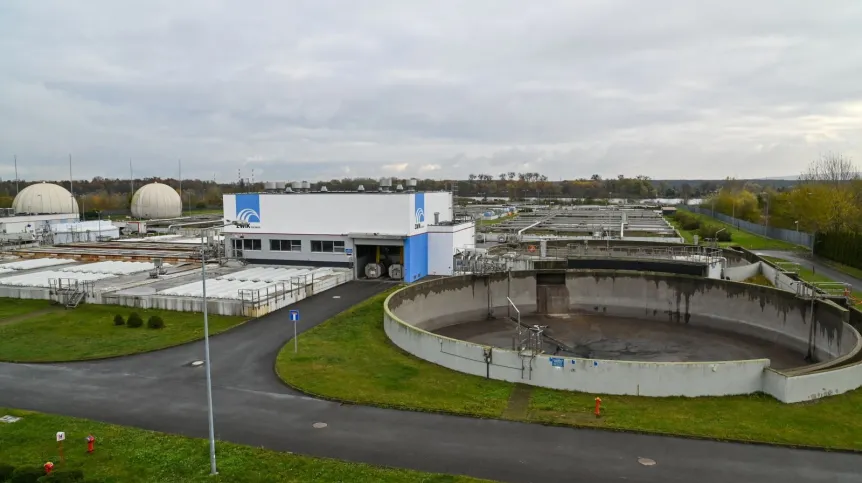
The Pomorzany Sewage Treatment Plant is testing a pilot station that detects and removes PFAS compounds and micropollutants. The research results will enable the construction of an effective level 4 treatment installation, in accordance with the new EU urban wastewater treatment directive.
A mobile station for detecting micropollutants and harmful chemicals in wastewater operates at the largest Szczecin treatment plant 'Pomorzany'. The container houses an installation for testing, filtering, and ozonation. Measuring devices and appropriate software precisely determin what was in the water 'at the input' and 'at the output'.
'The purpose of the pilot station is to allow us to verify the technical possibilities of wastewater treatment in terms of removing PFAS compounds and micropollutants', says Piotr Miakoto, manager of the 'Pomorzany' treatment plant. 'The station consists of three elements: initial treatment takes place on a fabric filter, then there is an ozonation process and finally an activated carbon column'.
Miakoto explains that the mobile station, which will be testing water in the Szczecin treatment plant until mid-December, is a mini version of the level 4 treatment installation, which must be built by 2033. According to the new EU urban wastewater treatment directive, all treatment plants in Europe are to not only improve the technologies for removing nitrogen compounds (by 20 percent) and phosphorus compounds (by 50 percent) from water in the coming years, but also effectively remove micropollutants and pharmaceuticals.
'The new EU directive will mean that level 3 treatment will have to be boosted. Biological treatment. But there is also a complete novelty, namely pharmaceuticals and microplastics found in foils, Teflon, Gore-Tex', Miakoto points out.
PFAS are perfluoroalkyl substances, harmful chemical pollutants. They are found in waterproof jackets and fire extinguishing foams, among other things.
The manager estimates that 'level 4' requires expanding the wastewater treatment plant installation by 30-40 percent. This means large and expensive investments. 'This is basically the construction of a water treatment plant', Miakoto says.
He adds that thanks to the mobile station and the conducted research, the Szczecin Water and Sewage Company, which operates two wastewater treatment plants in the city ('Pomorzany' and 'Zdroje'), is 'two years ahead' compared to other Polish water supply companies. 'When it comes to the investment itself, we will not proceed blindly, we will have our local wastewater tested', Miakoto points out.
Samples for testing are taken at individual stages of treatment. The analyses are carried out by the laboratories of the Szczecin Water and Sewage Company and the West Pomeranian University of Technology.
‘Twenty-four PFAS compounds and 12 pharmaceuticals are being detected. These compounds accumulate in the environment, especially PFAS compounds, they are not biodegradable', says Natalia Piętka, a technologist at the 'Pomorzany' treatment plant. 'We do not have full results yet, but we know that most of these 12 pharmaceuticals are present in wastewater'.
She adds that only some of the pharmaceuticals are removed at 'level 3'. On the other hand, out of 24 PFAS compounds detected in the 'Pomorzany' treatment plant, five to eight were found. 'So it is not that much, but they are there and they are not removed at the biological treatment stage, so level 4 treatment is needed', Piętka says.
Miakoto emphasises that the stricter standards for the treatment of wastewater that ends up in the Odra River mean benefits for residents and the environment. He reminds that 'many cities' in the region draw water from rivers. Its quality will improve. The lack of harmful substances will have a positive impact on the condition of microorganisms and fish. 'All of these substances accumulate in fish, then we eat these fish and the substances are deposited in our livers', he says.
The micropollutant detection station was developed as part of the EMPEREST project, which involves representatives of water supply companies, scientists, chemical engineering and environmental protection specialists, local authorities from the Baltic Sea countries: Poland, Germany, Finland, Estonia, Lithuania, Latvia. The leader is the Union of the Baltic Cities Sustainable Cities Commission based in Turku, Finland. The project will continue until December 2025. Its budget is over EUR 5.4 million. EU funding amounts to 80 percent.
Find out more about the project here.
The mobile station was built in Gdańsk, from where it was transported to Szczecin in August. At the turn of the year, it will be transported to Kaunas in Lithuania. Later, it will test water in Riga and other places. (PAP)
tma/ zan/ kap/
tr. RL













